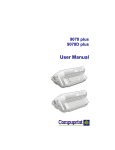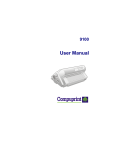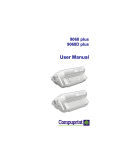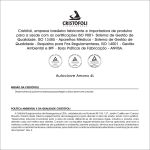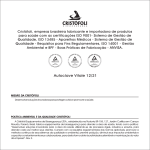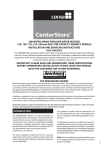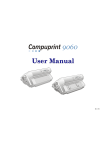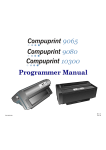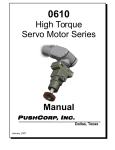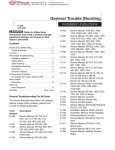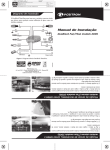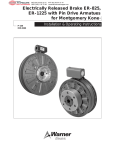Download User Manual
Transcript
PrintStation 60 PrintStation 70 User Manual ® Copyright 1999 Output Technology Corporation This manual refers to various companies and products by their trade names. In most of the cases, these designations are claimed as trademarks or registered trademarks by their respective companies. 2310 N.Fancher Rd. Spokane, WA 99212-1381-USA (509) 536-0468 Internet Address: ftp.output.com/public/output http://www.output.com 066-0057 9-00' Rev A FCC Regulations This equipment has been tested and found to comply with the limits for a Class B digital device, pursuant to Part 15 of the FCC Rules. These limits are designed to provide reasonable protection against harmful interference when the equipment is operated in a commercial environment. This equipment generates, uses and can radiate radio frequency energy and, if not installed and used in accordance with the instruction manual, may cause harmful interference to radio communications. However, there is no guarantee that interference will not occur in a particular installation. If this equipment does cause harmful interference to radio or television reception, which can be determined by turning the equipment off and on, the user is encouraged to try to correct the interference by one or more of the following measures: • • • Reorient or relocate the receiving antenna. Increase the separation between the equipment and the receiver to outlets on different circuits. Consult the dealer or an experienced radio/TV technician for help. Changes or modifications not expressly approved by the party responsible for compliance could void the user's authority to operate the equipment. The use of a non-shielded interface cable with the referenced device is prohibited. The length of the parallel interface cable must be 3 meters (10 feet) or less. The length of the serial interface cable must be 15 meters (50 feet) or less. Canadian D.O.C. Radio Interference Regulation This digital apparatus does not exceed the Class B limits for radio noise emission from digital apparatus as set out in the radio interference regulations of the Canadian Department of Communications. Le présent appareil numérique n'émet pas de bruits radioélectriques dépassant les limites applicables aux appareils numériques de classe B prescrites dans le règlement sur le brouillage radioélectrique édicté par le ministère des communications du Canada. EEC Regulations This equipment conforms to the EEC Directive 89/392 (the sound pressure, measured according to ISO 7779, does not exceed 70 dBA). i Safety Information Safety Information ✍ A. Never remove any printer cover unless it is necessary for the installation of a printer accessory and expressly described in this manual. B. Please retain the printer covers in a safe place because they should be reinstalled if you decide to remove any printer accessory. The following areas of the printer should be covered for safety reasons: R ear C over Pa pe r S tacker O pen in gs L arg e R ear C o ve r The above openings must always be protected with their cover when the corresponding option is not installed. Do not touch inside and do not insert any object into these openings or into the gears. ii Table of Contents Table of Contents Getting to Know Your Printer ................................................................ 1 Unpacking Your Printer ...................................................................... 1 PrintStation 60 & PrintStation 70 Parts............................................ 2 Front View ........................................................................................ 2 Rear View ......................................................................................... 2 Setting Up Your Printer .......................................................................... 3 Choosing a Suitable Location.............................................................. 3 Printer Assembly ................................................................................. 4 Removal of the Shipment Locks ...................................................... 4 Ribbon Cartridge Installation ......................................................... 4 Upper Push Tractor Installation (option) ....................................... 7 Host Computer Connection ................................................................. 9 Printer Driver Selection ...................................................................... 9 Power Connection .............................................................................. 10 Selecting the Display Language.......................................................... 11 Configuring the Printer......................................................................... 12 Operator Panel Presentation ............................................................ 12 Display Messages ........................................................................... 12 Indicators ........................................................................................ 13 Function Keys................................................................................. 13 Printer Setups .................................................................................... 17 Entering the Printer Setups .......................................................... 17 Moving within the Printer Setups ................................................ 17 Leaving the Printer Setups ........................................................... 17 Power-On Configuration.................................................................... 18 Entering the Power-On Configuration ......................................... 18 Program Setup ................................................................................... 30 Entering the Program Setup ......................................................... 30 How to Select the Paper Path ........................................................... 40 iii Table of Contents How to Use the Tear-Off Function.................................................... 41 Selection of the Paper Size ............................................................ 41 Adjusting the Tear-Off Position .................................................... 41 Selection of the Tear-Off Mode...................................................... 42 How to Lock/Unlock the Access to the Printer Setups .................... 43 Paper Handling...................................................................................... 44 Paper Paths ........................................................................................ 44 Fanfold Paper Specifications............................................................. 45 Loading Fanfold Paper ...................................................................... 45 Loading Paper Using the Lower Tractor ...................................... 45 Loading Paper Using the Upper Tractor (option) ........................ 50 Printer Maintenance and Troubleshooting......................................... 53 Cleaning the Printer .......................................................................... 53 Replacing the Ribbon Cartridge........................................................ 54 Printing the Self Test ........................................................................ 55 Error Handling................................................................................... 55 Printer Specifications ........................................................................... 58 iv Getting to Know Your Printer Getting to Know Your Printer • • • • • • • • • • • 18 Needle Print Head 136 columns PS60 model: Draft printing at 500 cps, HS Draft printing at 600 cps, LQ printing at 210 cps, DP Text printing at 350 cps. PS70 model: Draft printing at 700 cps, LQ printing at 210 cps, DP Text printing at 350 cps. IBM Proprinter XL III, Personal Printer 2381 and EPSON FX 1050 emulations High Resolution Graphics Printing (240 x 144 dots per inch) Multiple copies (1 original and 7 copies) Automatic paper path selection Easy operability via operator panel setup and software commands Special Windows print drivers Plug & Play capability for Windows 95 Bi-directional IEEE 1284 parallel interface and standard serial RS-232/C and RS-422/A interface Unpacking Your Printer The following items are included in the box: ✍ The user manual is on the CD-ROM. If you find any damage to the printer, notify your delivery person immediately. C D -R O M R ib bon C artridg e U pp er Pu sh Tractor (Op tion) P ow e r C ab le 1 Getting to Know Your Printer PrintStation 60 & PrintStation 70 Parts Front View O pe rato r Pa ne l P aper K no b P ush Tracto rs C ove r P ow er Sw itch Rear View R e ar P ap er S lo t Top C o ve r R e ar C ov er P a pe r K no b In te rfa ce C o nn ec to rs L arg e R ea r C o ver P o w er C ab le C o nn ecto r 2 Setting Up Your Printer Setting Up Your Printer Choosing a Suitable Location Consider the following points when you choose the location for your printer: • The distance between the printer and the host computer must not exceed the length of the interface cable; • The location must be sturdy, horizontal and stable; • Your printer must not be exposed to direct sunlight, extreme heat, cold, dust or humidity (see "Printer Specifications" at the end of manual); • You need an AC power outlet compatible with the plug of the printer's power cord. The voltage of the outlet must match the voltage shown on the printer's Rating Plate; Additionally, you must make sure that when you install the printer in the selected location, there are sufficient clearances on all sides for easy operation. The required space is shown below: 8 0 cm 3 1 .5 in . 1 39 00 .4 cm in m 2 0 c in 7 .9 cm 0 in 1 0 .4 39 m 20 c 7 . 9 in 3 Setting Up Your Printer Printer Assembly Removal of the Shipment Locks Open all the printer covers and make sure that you remove all the shipment locks (blocks and wedges) from the printer. Ribbon Cartridge Installation 1. Make sure that the printer is turned off. 2. Find the ribbon cartridge among the accessories. R ib b on gu id e Ten sion K n ob C a rtrid g e P in 4 Setting Up Your Printer 3. Turn the printer on. The print carriage prepares for ribbon cartridge installation. 4. Open the top cover using the small handles on either side of the top cover. The print head moves towards the front of the printer for easier cartridge installation. 5. Before installing the ribbon cartridge turn the ribbon winding knob in the arrow direction (located on the cartridge) to take up slack in the ribbon. ✍ R ib b on Ten sion K n ob To avoid damage to the ribbon, do not turn the winding knob in the wrong direction. 5 Setting Up Your Printer 6. Align the cartridge pins with the locking grooves on the left and right cartridge supports. 7. Slide and insert the ribbon guide between the print head and the ribbon guide mask holding it perpendicular to the print head. ✍ Make sure that the ribbon is inserted correctly between the print head and the print head mask. 2. 8. Turn the ribbon winding knob in the arrow direction (located on the cartridge) to take up slack in the ribbon. 6 12 R ibb on Tension K nob Setting Up Your Printer 9. Push the cartridge down gently until it clips into place at all four locking points. 10. Turn the ribbon winding knob again in the direction of the arrow to take up slack in the ribbon. 11. To ensure that the ribbon guide runs freely along the ribbon, manually move the print carriage horizontally. If you need to replace the used ribbon cartridge, see "Replacing the Ribbon Cartridge" on page 54. Upper Push Tractor Installation (option) A second optional push tractor unit unit can be installed in front position (on the lower push tractor). 1. Find the optional upper push tractor. 7 Setting Up Your Printer 2. Install the upper push tractor aligning both its hooks with the lower push tractor pins and inserting them into the corresponding pins. Push the upper tractor until it is fully engaged. Insert the connector cable in the electrical connector located in the lower push tractor. Low er Tra ctor P in U pper Tra ctor H ook E lectrical C on ne ctor C onnecto r C a ble 3. The upper push tractor must be installed as shown in figure. 4. If you need to remove the upper push tractor, turn the printer off. Take the connector cable off and press on the internal levers (located in the upper push tractor hooks) to disengage the tractor. 8 Setting Up Your Printer Host Computer Connection This printer can be connected to your host computer via two available interfaces. The interface connectors are located on the rear of the printer. • • A bi-directional IEEE1284 parallel interface A RS-232C/422A serial interface ✍ Before connecting the interface cable, make sure that the printer and the host computer are turned OFF . Insert the parallel interface cable into the parallel connector and fasten it by means of the clips. Insert the serial interface cable into the serial connector, and fasten it using the two screws.. Parallel Interface Serial Interface Printer Driver Selection Windows printer drivers are included with the printer. Follow the instructions in the readme file on the CD-ROM. In a WINDOWS 95 environment the printer supports the Plug & Play feature. ✍ The printer drivers of all Output Technology printers can be found at the Internet Address http://www.output.com. 9 Setting Up Your Printer Power Connection Make sure that the power outlet matches the power rating of the printer. See the name plate of the printer, that you find under the large rear cover. In case the power rating does not correspond DO NOT CONNECT THE PRINTER TO THE MAINS. Consult your dealer for help. 1. Make sure the power outlet is near the printer location and easily accessible. ✍ Always use a grounded outlet. 2. Make sure that the power switch is in 0 position (OFF). 3. Insert the power cable plug into the printer connector and the other power cable end into a convenient outlet. 1 4. To turn the printer on, press the power switch in the I position (ON). 10 2 Selecting the Display Language Selecting the Display Language The display messages for this printer can be displayed in five different languages: English (Default), French, German, Italian and Spanish. To select the language, that you prefer, proceed as follows: 1. Press the PROGRAM key while powering the printer on and keep it pressed until the following message is displayed RELEASE THE KEY 2. When the PROGRAM key is released, the following messages are displayed : or PS 60 PS 70 then, PRINT OUT? NO 3. Press the ↓ key to enter the setup. The first setup item is displayed: PARALL INTERFACE 4. Press the ↓ key until the language first level function is displayed: FUNCTIONS 5. Press the → key to pass to the second level functions: HIGH SPEED or (PS60 model) SEQUENCE NONE (PS70 model) 6. Press the ↓ key until the setup language is displayed: MENU ENGLISH 7. Press the → key to scroll the setup languages. When the desired language is displayed, press the PROGRAM key to select it. The printer exits the setup. From now on the display messages appear in the selected language. 11 Configuring the Printer Configuring the Printer Operator Panel Presentation The operator panel enables you to perform many of the printer functions including paper path selections, font selection and the printer setup. R EAD Y QUIET L OAD /FF ↓ M IC R O F EED LF M A CR O PAT H FO N T PAR K ↑ PROGRAM O N L IN E PROGRAM PITC H SH IFT SH IFT The operator panel consists of: • • • A 16 character display (Liquid Crystal Display) Three function mode indicators Seven function keys Display Messages Instruction Messages Message LOAD LOWER PUSH LOAD UPPER PUSH RELEASE KEY Description These messages are displayed when the corresponding paper path is out of paper. The printer displays only the messages related to the installed devices. This message is displayed when you can release the PROGRAM key while powering on the printer. User Intervention Messages Message PARK: SURE? MACRO CHANGING PATH CHANGING 12 Description The user must confirm the parking of the paper. The macro has been changed and the printer is updating the settings. The path has been changed and the printer is updating the settings. Configuring the Printer Status Messages Message font cpi LOWER PUSH MENU LOCKED Description The printer is offline or online without printing. The lower push paper path is selected. The printer displays this message when the access to the Printer Setups has been locked. MENU UNLOCKED The printer displays this message when the access to the Printer Setups is not locked. MICRO FEED DOWN ↓ The paper is fed in microsteps downwards when pressing the arrow key. The paper is fed in microsteps upwards when MICRO FEED UP ↑ pressing the arrow key. QUIET PRINT OFF Printing at normal noise level. QUIET PRINT ON Printing at reduced noise level. UPPER PUSH The upper push paper path is selected. SELF TEST Printing the self-test page. Indicators R EAD Y PROGRAM SH IFT Lit when the printer can receive and print data (printer online). Blinks when there is data in the buffer and the printer is offline. Unlit, when the printer is disabled and the buffer does not contain any data, or during the initialization, setup or tests. Blinks when one of the printer setup procedures has been selected: Program Setup or Power-On Configuration. Blinks when the alternate function of the keys has been enabled pressing the SHIFT key. Function Keys The function keys are enabled, when the printer is offline. (READY indicator unlit). The function keys have three functions each. 13 Configuring the Printer The normal function of the keys does not require previous action to select it. This function is indicated in black characters beside the function keys. The alternate function is selected pressing the Shift Function SHIFT key. The alternate functions of the keys are described on the gray areas beside the keys. The SHIFT indicator blinks. This function is not enabled, if the printer is in setup mode. Program Function The program function is selected pressing the PROGRAM key, where: • If you press the key while powering on the printer, the Power-On Configuration is selected. • Pressing the key when the printer is enabled without printing or disabled (READY indicator unlit), the Program Setup is selected. In the Program Setup mode only the four arrow keys and the PROGRAM key are enabled. When the printer is in setup mode, the PROGRAM indicator blinks. Normal Function ON LINE Key ON LINE Normal Function • • • • Enables or disables the printer. If this key is pressed while powering the printer on, the self test is printed; the printout is stopped pressing this key again. In an error condition, once the error cause has been removed, press this key to enable the printer. If the Tear-Off Function in the Program Setup is set to Manual, press this key to position the paper for the Tear-Off. Program Function Pressing this key, the input buffer is cleared and a break (250 msec.) on a serial interface is sent. The message RESET & BREAK is displayed. 14 Configuring the Printer PROGRAM Key PROGRAM PITCH Normal Function Shift Function Program Function Enables the printer setups as follows: • Pressing this key while powering on the printer, the Power-On Configuration is selected. • Pressing this key when the printer is enabled without printing or disabled (READY indicator unlit), the Program Setup is enabled. Selects the pitch to be used with the currently selected font. The selected pitch is valid until the printer is turned off. Exits the current printer setup. See later “Leaving the Printer Setups” on page 17. SHIFT Key SHIFT Normal Function Shift Function Enables the alternative key functions. Disables the alternative key functions. LOAD/FF Key LOAD/FF Normal Function ↑ Shift Function ↑ Program Function Executes a Form Feed (FF): when paper is loaded into the printer, it advances to the following page; if no paper is loaded, it is positioned for printing. Moves the paper forward in microsteps. Keeping the key pressed the paper is moved continuously at increasing speed. Scrolls the parameters of the functions or macros backwards. LF Key LF Normal Function ↓ Shift Function ↓ Program Function Performs a line feed according to the current line spacing settings. Moves the paper backward in microsteps. Keeping the key pressed the paper is moved continuously at increasing speed. Scrolls the setup and macro functions forward. 15 Configuring the Printer MACRO Key MACRO PATH ← Normal Function Selects one of the user macros (Macro 1, Macro 2, Macro 3 or Macro 4). If you want to select the displayed macro, wait for 2 seconds without pressing any key and the parameters of this macro will be set. Shift Function Selects one of the paper paths. The parameters of the displayed path are set pressing the SHIFT key or waiting for 2 seconds without pressing any key. Program Function Scrolls the setup and macro functions backward. FONT Key FONT PARK → Normal Function Selects the font to be used with the currently selected pitch. The selected font is valid until the printer is turned off. Shift Function Parks the paper in the currently selected paper path. Program Function Scrolls the setup and macro functions forward. Key Combinations PROGRAM + SHIFT Normal Function ONLINE Normal Function + MACRO + SHIFT 16 When the printer is on line without printing or printing data (READY indicator lit) or when the printer is unable to receive and print data but there is still data in the input buffer (READY indicator blinks) pressing these two keys contemporaneously will toggle the printing noise level between normal (QUIET PRINT OFF) and reduced noise level (QUIET PRINT ON). When the printer is off line (READY indicator unlit), the printing noise level function is disabled. Lock or unlock the access to the printer setups. See later “How to Lock/Unlock the Access to the Printer Setups” on page 43. Configuring the Printer Printer Setups The main printer setup parameters can be selected via the operator panel. The setup parameters are divided into two printer setups, the Power-On Configuration, that allows a complete configuration at installation time according to the hardware and the emulation types, and the Program Setup, that allows you to set the functions that are the most useful in your daily job. This settings can be selected when the printer is in online without printing or offline (READY indicator unlit). These settings can be stored in the NVRAM. Entering the Printer Setups • Press the PROGRAM key at the printer power on. Keep the PROGRAM key pressed (PS60 or PS70 message is displayed) until the RELEASE KEY message is displayed to select the Power-On Configuration. • Press the PROGRAM key when the printer is online without printing or offline (READY indicator unlit) to select the Program Setup. Moving within the Printer Setups The arrow keys ↑, ↓, ← , → are used to move within the different functions inside the Printer Setups. See the following description of the Setup items. Leaving the Printer Setups • In the Power-On Configuration pressing the PROGRAM key the printer exits from the setup and the new settings will be automatically saved. • In the Program Setup pressing the PROGRAM key, the following choice is offered for the storage of the values set: STORE? QUIT The new settings are not activated and the old settings remain valid. STORE? SAVE The new settings are stored permanently in the NVM (Non Volatile Memory). STORE? CURRENT The new settings remain valid until the printer is turned off. Press the → or ← keys to scan these selections forward and backwards. When the desired setting is displayed, press the PROGRAM key to exit from the setup. 17 Configuring the Printer Power-On Configuration The default values of the various functions are indicated in bold. Entering the Power-On Configuration 1. Make sure that the printer is turned off. 2. Press and hold the PROGRAM key until the RELEASE KEY message is displayed. As soon as the PROGRAM key gets released, the following message will be displayed: PS 60 or PS 70 then, PRINT OUT? NO The following figure shows the structure of the Power-On Configuration and how to move inside the Setup. Main Structure Print out? NO Print out? YES Parallel Interface Parallel Interface Settings Serial Interface Serial Interface Settings Functions Functions Block Back to MFG? NO Back to MFG? YESENU BLOCK The functions concerning the interfaces group the parameters for the configuration of the interfaces. The setup item Functions groups the following printer functions: • • • • • • • • • 18 Selection of the Draft or High Speed Draft printing (only PS60 model), Paper loading sequence, Buzzer setting, Ribbon type, Text printing direction, Graphics printing direction, Bar code printing direction, Paper path at power on, Language of the display messages. Configuring the Printer Printout of the Printer Settings → or ← PRINT OUT? NO PRINT OUT? YES ↓ PARALL INTERF PRINT OUT? NO PRINT OUT? YES The Setup is not printed. The printer setup is printed showing the currently selected values. The printout starts as soon as you select this value. Parallel Interface This setup defines the use of the parallel interface and is structured according to the interface specific parameters. Parallel Interface Parameters Parall. Interface I/F Parallel Cx 1284 Bidir I/F Select-In Host Select-In On Data Bits 8 Data Bits 7 Dedic. Buffer 256 Dedic. Buffer ... Emul. EPSON ... Emul. IBM ... Char. Set ... Char Set ... Nation ... Nation ... Auto CR ... Auto CR ... Auto LF ... Auto LF ... 20 CPI IBM ... Serial InterfaceENU BLOCK 19 Configuring the Printer Setting the Interface Parameters Interface Type PRINT OUT? NO ↓ PARALL INTERFACE → ↓ SERIAL INTERFACE 1284 BIDIR I/F CX PARALLEL I/F PARALL INTERFACE ↑ 1284 BIDIR I/F CX PARALLEL I/F ↓ SELECT-IN HOST → or ← → or ← Bidirectional IEEE 1284 parallel interface. Centronics type parallel interface (monodirectional). Setting the Select-In Signal 1284 BIDIR. I/F ↑ SELECT-IN HOST SELECT-IN ON ↓ DATA BITS 8 SELECT-IN ON SELECT-IN HOST → or ← → or ← The SELECT-IN signal of the parallel interface is ignored and treated always as ON. The printer checks the SELECT-IN signal coming from the host. Number of Data Bits SELECT-IN HOST ↑ DATA BITS 8 DATA BITS 7 ↓ DEDIC.BUFFER 2K → or ← → or ← Selection of the number of data bits: 7 or 8. Input Buffer Size DATA BITS 8 ↑ DEDIC.BUFFER 256 DEDIC.BUFFER 2K DEDIC.BUFFER 12K DEDIC.BUFFER 32K DEDIC.BUFFER 64K ↓ EMUL. EPSON → or ← → or ← → or ← → or ← → or ← Selects the input buffer size. If the input buffer is set to 64K, down-loaded characters are not available. 20 Configuring the Printer Printer Emulation DEDIC.BUFFER2K ↑ EMUL. EPSON EMUL. IBM XLIII EMUL. IBM 2381 ↓ CHAR. SET CS2 EMUL EPSON EMUL IBM XLIII EMUL. IBM 2381 → or ← → or ← → or ← The printer uses EPSON ESC/P (FX 1050) emulation. The printer uses IBM Proprinter XL III emulation. The printer uses IBM Personal 2381 emulation. EPSON Character Sets EMUL. EPSON ↑ CHAR. SET CS1 CHAR. SET CS2 CHAR. SET ITALIC ↓ NATION CP437 → or ← → or ← → or ← These items select the character set to be used in EPSON emulation. IBM Character sets EMUL. IBM ↑ CHAR. SET CS1 CHAR. SET CS2 ↓ NATION CP437 → or ← → or ← These items select the character set to be used in IBM Proprinter emulation. EPSON National Character sets CHAR. SET CS2 ↑ NATION CP437 NATION ... NATION LATIN A1 ↓ AUTO CR YES → or ← → or ← → or ← The following national character sets are available: CP 437 CP 855 CP 864 GOST ISO 8859/5 USA ITALY LATIN A1 ✍ CP437 G CP 857 CP 865 TASS ISO 8859/6 FRANCE SPAIN1 CP 850 CP 858 CP 866 ISO 8859/1 ISO 8859/7 GERMANY JAPAN CP 851 CP 860 CP 867 ISO 8859/2 ISO 8859/8 ENGLAND NORWAY CP 852 CP 862 CP 876 ISO 8859/3 ISO 8859/9 DENMARK1 DENMARK2 CP 853 CP 863 CP 877 ISO 8859/4 ISO 8859/15 SWEDEN SPAIN2 The CP 858 and ISO 8859/15 character sets contain the Euro character. 21 Configuring the Printer IBM National Character Sets CHAR. SET CS2 ↑ NATION CP437 NATION ... NATION 8859- 15 ↓ AUTO CR YES → or ← → or ← → or ← The following national character sets can be selected: CP 437 CP 855 CP 864 GOST ISO 8859/5 ✍ CP437 G CP 857 CP 865 TASS ISO 8859/6 CP 850 CP 858 CP 866 ISO 8859/1 ISO 8859/7 CP 851 CP 860 CP 867 ISO 8859/2 ISO 8859/8 CP 852 CP 862 CP 876 ISO 8859/3 ISO 8859/9 CP 853 CP 863 CP 877 ISO 8859/4 ISO 8859/15 The CP 858 and ISO 8859/15 character sets contain the Euro character. CR Code Behavior NATION CP437 ↑ AUTO CR NO AUTO CR YES ↓ AUTO LF NO AUTO CR NO AUTO CR YES → or ← → or ← No automatic carriage return is performed after a LF, VT or ESCJ code. The printer performs an automatic carriage return after a LF, VT or ESCJ code . LF Code Behavior AUTO CR NO ↑ AUTO LF NO AUTO LF YES AUTO LF HOST (Parallel interface only) ↓ 20 CPI IBM NO or PARALL INTERFACE AUTO LF NO AUTO LF YES AUTO LF HOST (Parallel interface only) 22 → or ← → or ← → or ← No Automatic LF after CR. Automatic LF after CR. Only in EPSON emulation. The printer checks the AUTOFEEDXT signal coming from the host and executes an automatic LF after CR, if the signal is low . Configuring the Printer IBM Compressed Printing These items are displayed only, if the IBM emulation is selected. AUTO LF NO ↑ 20 CPI IBM NO 20 CPI IBM YES ↓ PARALL INTERFACE → or ← → or ← 20 CPI IBM NO 20 CPI IBM YES The compressed printing is performed at 17,1 cpi. The compressed printing is performed at 20 cpi. Serial Interface This setup defines the use of the serial interface and is structured according to the interface specific parameters. Serial Interface Parameters Serial Interface Serial I/F No Serial I/F ... Baud 300 Baud ... Data Bits 8 Data Bits 7 Parity None Parity ... Handshake DTR Handshake XONXOF Connect. local Connect. remote Dedic. Buffer 256 Dedic. Buffer ... Emul. EPSON Emul. IBM ... Char. Set ... Char Set ... Nation ... Nation ... Auto CR ... Auto CR ... Auto LF ... Auto LF ... 20 CPI IBM ... Functions onsNU BLOCK 23 Configuring the Printer Setting the Interface Parameters Interface Type PARALL INTERFACE ↑ SERIAL INTERFACE → ↓ FUNCTIONS SERIAL I/F NO SERIAL I/F 232 SERIAL I/F 422 SERIAL INTERFACE ↑ SERIAL I/F NO SERIAL I/F 232 SERIAL I/F 422 ↓ BAUD 9600 → or ← → or ← → or ← The serial interface is disabled. Defines the usage of the serial interface RS-232/C. Defines the usage of the serial interface RS-422/A. Baud Rate SERIAL I/F NO ↑ BAUD 300 BAUD 600 BAUD 1200 BAUD 2400 BAUD 4800 BAUD 9600 BAUD 19200 BAUD 38400 ↓ DATA BITS 8 → or ← → or ← → or ← → or ← → or ← → or ← → or ← → or ← The baud rate is selected in bits per second. The above values can be selected. Number of Data Bits BAUD 9600 ↑ DATA BITS 8 DATA BITS 7 ↓ PARITY NONE → or ← → or ← Selection of the number of data bits: 7 or 8. 24 Configuring the Printer Parity Check DATA BITS 8 ↑ PARITY NONE PARITY ODD PARITY EVEN PARITY MARK PARITY SPACE ↓ HANDSHAKE DTR PARITY NONE PARITY ODD PARITY EVEN PARITY MARK PARITY SPACE → or ← → or ← → or ← → or ← → or ← Data does not have a parity bit, i.e. 8 bit data are transferred and the parity check is disabled. Parity check is enabled for odd parity. Parity check is enabled for even parity. Parity check is disabled and the transmitted parity bit is always a Mark. Parity check is disabled and the transmitted parity bit is always a Space. Handshake Protocol PARITY NONE ↑ HANDSHAKE DTR HANDSHAKE XONXOF ↓ CONNECTION LOCAL HANDSHAKE DTR HANDSHAKE XONXOF → or ← → or ← The Handshake is performed using the DTR Protocol. The Handshake is performed using the XON-XOFF Protocol. Connection Type HANDSHAKE DTR ↑ CONNECTION LOCAL CONNECT. REMOTE ↓ DEDIC.BUFFER 2K → or ← → or ← Selects the connection type: local or remote. Input Buffer Size See the description of the parallel interface. Printer Emulation See the description of the parallel interface. EPSON Character Sets See the description of the parallel interface. 25 Configuring the Printer IBM Character sets See the description of the parallel interface. EPSON National Character sets See the description of the parallel interface. IBM National Character Sets See the description of the parallel interface. CR Code Behavior See the description of the parallel interface. LF Code Behavior See the description of the parallel interface. IBM Compressed Printing See the description of the parallel interface. Functions This item groups various printer functions, with which you can configure the printer. Functions Sequence No Seq. L+U Push Buzzer Yes Buzzer No Ribbon Black Ribbon Color Text Direct BI Text Direct UNI Graph Direct BI Graph Direct UNI BarCodes Dir.BI BarCodes Dir.UNI P.On Path Macro P.On Path Last Menu ENGLISH Menu . . . Back to Mfg? NoBak to onsNU BLOCK 26 Configuring the Printer Setting the Functions Group Items Paper Loading Sequence HIGH SPEED NO (PS60 model) or FUNCTIONS (PS70 model) ↑ SEQUENCE NONE → or ← SEQ. L+U PUSH → or ← ↓ BUZZER YES ✍ The SEQ.L+U PUSH item is displayed only, if the upper push tractor is installed. SEQUENCE NONE SEQ. L+U PUSH The paper is fed only through the path selected by operator panel. The printer first feeds paper through the lower push path and later switches to the upper push path. Enable/Disable the Buzzer SEQUENCE NONE ↑ BUZZER YES BUZZER NO ↓ RIBBON BLACK → or ← → or ← Enable or disables the buzzer. Ribbon Type Selection BUZZER YES ↑ RIBBON BLACK RIBBON COLOR ↓ TEXT DIRECT BI → or ← → or ← Selects the ribbon type to be used with the printer: black or color. (Color is not used with this printer. Text Print Direction RIBBON BLACK ↑ TEXT DIRECT BI TEXT DIRECT UNI ↓ GRAPH DIRECT BI → or ← → or ← Selects the print direction for text: bidirectional or unidirectional. 27 Configuring the Printer Graphics Print Direction TEXT DIRECT BI ↑ GRAPH DIRECT BI GRAPH DIRECT UNI ↓ BARCODES DIR.UNI → or ← → or ← Selects the print direction for graphics: bidirectional or unidirectional. Bar Codes Print Direction GRAPH DIRECT BI ↑ BARCODES DIR.BI BARCODES DIR.UNI ↓ P. ON PATH MACRO → or ← → or ← Selects the print direction for bar codes: bidirectional or unidirectional. Paper Path at Power-On BARCODES DIR.UNI ↑ P. ON PATH MACRO P. ON PATH LAST ↓ MENU ENGLISH P. ON PATH MACRO P. ON PATH LAST → or ← → or ← The paper path at power-on is the one from the default Macro. The paper path at power-on is the last one that was selected before the printer was powered off. Selection of the Language of the Display Messages P. ON PATH MACRO ↑ MENU ENGLISH MENU ITALIANO MENU FRANCAIS MENU ESPANOL MENUE DEUTSCH ↓ FUNCTIONS → or ← → or ← → or ← → or ← → or ← These items are self explaining. ✍ 28 See also “Selecting the Display Language” on page 11. Configuring the Printer Resetting to Factory Default Values With the BACK TO MFG function it is possible to reset all items in the Power On Configuration and in the Program Setup to their factory default values. This may be useful if you do not remember the values you set in the menus, or because you simply changed you mind about the settings you have just done. The default values for the setup items are indicated in bold. FUNCTIONS ↑ BACK TO MFG: NO ↓ or PROG PRINT OUT ? → or ← BACK TO MFG: YES If you want to select BACK TO MFG:YES, you have to exit from this item using the ↑ or the ↓ key, in order to confirm the selection of this value. At this point, the Power On Configuration Setup procedure is finished. If you exit pressing the ↓ and the PROGRAM key, the new settings will be saved. Do not power off the printer before all data have been written into the NVRAM and the printer has returned online. 29 Configuring the Printer Program Setup The default values of the various functions are indicated in bold. Entering the Program Setup Press the PROGRAM key when the printer is turned on and is offline or online without printing. The following message will be displayed: PRINT OUT? NO The following figure shows the structure and how to move inside the Program Setup. Main Structure Print out? No Print out? Yes User macro Macro# 1 Line sp. 6 lpi ... ... Macro# 4 Line sp. ... MACRO PARAMETER BLOCK Next Macro? NO Next Macro? YES Config. Menu? NO Config. Menu? YES Hex Dump? NO Hex Dump? YES Parall. Interface ... Tear adjust 0 Tear adjust ... Serial Interface ... ... CONFIGURATION MENU BLOCK The items define the following parameters: • • • • 30 Four user macros The direct access to the Power-On Configuration Hexadecimal printout Tear-Off adjustment Configuring the Printer Printout of the Printer Settings PRINT OUT? NO ↓ USER MACRO PRINT OUT? NO PRINT OUT? YES → or ← PRINT OUT? YES The Setup is not printed. The printer setup is printed. The printout starts as soon as you select this value. NOTE: The Program setup printout indicates: • • • the currently selected values, the current selected macro is marked with the #x# symbols (USER MACRO #x#), the current firmware release. USER MACRO The USER MACRO item allows to prepare four printing environments (MACRO#1, MACRO#2, MACRO#3 and MACRO#4). Each macro is composed of a group of parameters which define a configuration that can then be recalled to easily set the printer for four printing environments. SELECTION OF THE USER MACRO PRINT OUT? NO ↓ USER MACRO ↓ CONFIG MENU NO → USER MACRO ↑ MACRO # 1 MACRO # 2 MACRO # 3 MACRO # 4 ↓ LINE SP. 6 LPI → or ← → or ← → or ← → or ← Selection of the macro for which you intend to set the parameters. ✍ When a new macro is selected and the fanfold paper is present in the paper path set in the previous macro, it will be automatically parked (PARK: SURE? is displayed).Tear off this fanfold paper to avoid paper jams and press PARK key. 31 Configuring the Printer USER MACRO PARAMETERS U ser m a cro C onfig. M e nu N o 32 M acro # 1 M acro #2 M acro # 3 M acro #4 Lin e S p. 6 lpi Lin e S p. ... Lin e S p. Lock N o Lin e S p Lock Yes Len gth 1 Line Len gth ... Top of F orm 0 Top of F orm ... S kipover 0 S kipover ... D raf M ode H S D raft M ode N orm Fo nt D raft Fo nt ... P itch 10 cpi P itch ... P itch Lo ck N o P itch Lo ck Yes Left M argin 0 Left M argin ... R ig ht M argin 2 R ig ht M argin ... S lash Ze ro N o S lash Ze ro Yes P ath L ow er P ush P ath ... Tear N orm al Tear ... S tron g Im pact S oft Im pact P erfo r. S afe? N o P erfo r. S afe? Yes A utogap 0 A utogap ... Tuning:H oriz 0 Tuning:H oriz ... Tuning:Vert 0 Tuning:Vert ... M acro->M F G N o M acro->M F G Yes N ext M acro? N o N ext M acro? Yes Configuring the Printer Line Spacing MACRO# 1 → MACRO # 1 ↑ LINE SP. 6 LPI LINE SP. 8 LPI LINE SP. 12 LPI LINE SP 3L/30MM LINE SP 4L/30MM LINE SP 6L/30MM LINE SP 8L/30MM LINE SP 12L/30MM ↓ LINE SP LOCK NO → or ← → or ← → or ← → or ← → or ← → or ← → or ← → or ← These values define the line spacing in lines/inch (6, 8, 12) or in lines per 30 mm (3, 4, 6, 8, 12). Line Spacing Lock LINE SP. 6 LPI ↑ LINE SP. LOCK NO LINE SP. LOCK YES ↓ LENGTH xxx LINE SP. LOCK NO LINE SP. LOCK YES → or ← → or ← Setting this item, the value set for vertical spacing can be changed by software or operator panel Setting this item, the value set for vertical spacing cannot be changed by software but only by operator panel. Page Length LINE SP. LOCK NO ↑ LENGTH 1 LINE LENGTH . .. LINES LENGTH 244 LINES LENGTH A5 LENGTH A4 LENGTH A3 LENGTH A2 LENGTH LEGAL LENGTH LETTER ↓ TOP OF FORM 0 → or ← → or ← → or ← → or ← → or ← → or ← → or ← → or ← → or ← These items set the page length for fanfold paper in number of lines depending on the current vertical spacing or the standard formats LETTER, LEGAL, A2, A3, A4, A5. Default value is 66 lines. 33 Configuring the Printer Top of Form LENGTH Xx ↑ TOP OF FORM 0 TOP OF FORM ... TOP OF FORM xxx ↓ SKIPOVER 0 → or ← → or ← → or ← These items set the top of form. The values range between 0 and the page length - 1. Skip Over Perforation TOP OF FORM 0 ↑ SKIPOVER 0 SKIPOVER ... SKIPOVER xxx ↓ FONT Draft → or ← → or ← → or ← These items set the skipover perforation. The values range between 0 and the page length - 1. Draft Mode Selection (PS60 Model only) SKIPOVER 0 ↑ DRAFT MODE HS DRAFT MODE NORM ↓ FONT Draft DRAFT MODE HS DRAFT MODE NORM → or ← → or ← Selects the HS Draft mode printing. Selects the Draft mode printing. Font Selection SKIPOVER 0 ↑ FONT Draft FONT Courier FONT OCR-B FONT Gothic FONT OCR-A FONT DP Text ↓ PITCH 10 CPI → or ← → or ← → or ← → or ← → or ← → or ← Selects the fonts. OCR-A is displayed only if a non proportional pitch has been selected. 34 Configuring the Printer Pitch Selection FONT Draft ↑ PITCH 5 CPI PITCH 6 CPI PITCH 7.5 CPI PITCH 8.5 CPI PITCH 10 CPI PITCH 12 CPI PITCH 15 CPI PITCH 17.1 CPI PITCH 20 CPI PITCH PROP PITCH PROP E PITCH PROP C ↓ PITCH LOCK NO → or ← → or ← → or ← → or ← → or ← → or ← → or ← → or ← → or ← → or ← → or ← → or ← These items set the horizontal spacing in characters per inch. The PROP item sets proportional character spacing. PROP E stands for expanded proportional, PROP C sets compressed proportional printing. Pitch Lock PITCH 10 CPI ↑ PITCH LOCK NO PITCH LOCK YES ↓ LEFT MARGIN 0 PITCH LOCK NO PITCH LOCK YES → or ← → or ← Setting this item, the pitch can be changed by software or operator panel. Setting this item, the pitch can be changed ONLY by operator panel. Left Margin PITCH LOCK NO ↑ LEFT MARGIN 0 LEFT MARGIN ... LEFT MARGIN xxx ↓ RIGHT MARGIN 136 → or ← → or ← → or ← The Left Margin is set in number of columns (depending on the current pitch) starting from the physical left edge. 35 Configuring the Printer Right Margin LEFT MARGIN 0 ↑ RIGHT MARGIN. 2 RIGHT MARGIN. ... RIGHT MARGIN. xxx ↓ SLASH ZERO NO → or ← → or ← → or ← The Right Margin is set in number of columns (depending on the current pitch) starting from the physical left edge. The default value is 136. Zero Character Printing RIGHT MARGIN 136 ↑ SLASH ZERO NO SLASH ZERO YES ↓ PATH LOWER PUSH → or ← → or ← You can select the Zero character printing with or without a slash. Paper Path Selection This function defines the default paper path for the current macro. SLASH ZERO NO ↑ PATH LOWER PUSH PATH UPPER PUSH PATH PUSH PULL ↓ TEAR NORMAL PATH LOWER PUSH PATH UPPER PUSH PATH PUSH PULL → or ← → or ← → or ← Paper loading with the lower push tractor. Paper loading with the upper push tractor. Paper loading using the lower push tractor and the rear pull tractor. (Pull tractor is not used with this printer.) Tear-Off Mode PATH LOWER PUSH ↑ TEAR NORMAL TEAR AUTOMATIC LABELS TEAR NO ↓ STRONG IMPACT TEAR NORMAL 36 → or ← → or ← → or ← → or ← The Tear-Off Function is performed pressing the ONLINE key when the printer is offline . Configuring the Printer TEAR AUTOMATIC When the printer is not receiving any data, the paper is moved to the Tear-Off position. It is returned to the Tear-Off position as soon as it receives printing data. This item must be set when printing on labels, in order to avoid paper jams. The paper does not execute any backward movement. The paper does not execute any backward movement. LABELS TEAR ✍ NO See also “How to Use the Tear-Off Function” on page 41. Print Impact Strength TEAR NORMAL ↑ STRONG IMPACT SOFT IMPACT ↓ PERFOR. SAFE NO STRONG IMPACT SOFT IMPACT → or ← → or ← The impact strength of the print head is set for printing on multicopy paper. The impact strength of the print head is set for printing on single-part paper (or paper with fewer than the maximum number of copy layers). The printing noise is reduced. Paper Perforation This function allows to move the print head to the side the paper when the horizontal fanfold perforation passes between the mylar and the print bar, to avoid paper jams. STRONG IMPACT ↑ PERFOR. SAFE NO PERFOR. SAFE YES ↓ AUTOGAP 0 → or ← → or ← PERFOR. SAFE NO The function is disabled. The print head remains in its position, when the perforation of the paper passes. PERFOR. SAFE YES The function is enabled. The print head is moved aside, when the perforation passes. Adjusting the Distance of the Print Head PERFOR. SAFE NO ↑ AUTOGAP -5 AUTOGAP ... AUTOGAP +3 MANUAL GAP FIXED GAP 0.3 → or ← → or ← → or ← → or ← → or ← 37 Configuring the Printer → or ← → or ← FIXED GAP ... FIXED GAP 9.3 ↓ TUNING.HORIZ 0 AUTOGAP xxx MANUAL GAP FIXED GAP xxx Selecting one of these values sensing the paper thickness. Negative values reduce the distance between the print head and the paper. Default value is AUTOGAP 0. Selecting this item, the print head must be adjusted manually. Selecting one of these values the printer adjusts the print head gap to a fixed distance. Horizontal Character Tuning AUTOGAP 0 ↑ TUNING:HORIZ 0 TUNING:HORIZ ... TUNING:HORIZ 60 ↓ TUNING.VERT 0 → or ← → or ← → or ← These values adjust the distance between the left paper margin and the first print character. The values correspond to 1/120 inch units, i.e. the tuning ranges between 0 and 0,5 inch. Vertical Character Tuning TUNING.HORIZ 0 ↑ TUNING.VERT: -24 TUNING.VERT: ... TUNING.VERT: 288 ↓ MACRO -> MFG NO → or ← → or ← → or ← These values adjust the distance between the top paper margin and the first printable line. The values correspond to 1/144 inch units, i.e. the tuning ranges between -1/6 and 2 inch. 0 is the default value. Resetting the Macro Parameters to the Factory Defaults TUNING.VERT. 0 ↑ MACRO -> MFG NO MACRO -> MFG YES ↓ NEXT MACRO? NO MACRO -> MFG NO 38 → or ← → or ← The new values set for the macro parameters will be the used. Configuring the Printer MACRO -> MFG YES The values set for the macro parameters will be reset to their factory defaults. Selecting Another Macro MACRO -> MFG NO ↑ NEXT MACRO? NO ↓ CONFIG MENU NO → or ← NEXT MACRO? YES ↓ MACRO # 1 To pass over to another macro, select NEXT MACRO YES. Pressing the ↓ or ↑ key the item MACRO#1 is displayed, then press the → key to pass over to MACRO#2 (MACRO CHANGING is displayed). ✍ When passing over from one macro to another, the fanfold paper loaded from the paper path, selected in the previous macro, will be automatically parked (PARK: SURE? is displayed). Tear off this fanfold paper to avoid paper jams and press PARK key. You can now set the parameters for Macro#2 as described above. In this way you prepare the second printing environment . Passing over from one macro to the other then sets two different printing environments. Passing over to the Power-On Configuration At this point of the setup, it is possible to pass over to the Power On Configuration Functions Setting. NEXT MACRO NO ↑ CONFIG MENU NO ↓ HEX DUMP NO → or ← CONFIG MENU YES ↓ PARALL INTERFACE These items are self-explaining. Hexadecimal Dump CONFIG MENU NO ↑ HEX DUMP NO ↓ TEAR ADJUST: xxxx → or ← HEX DUMP YES If you select HEX DUMP YES, press the PROGRAM key to set this item. The hexadecimal printing continues, until the HEX DUMP NO item is selected, entering again into the Program Setup. 39 Configuring the Printer Adjusting the Tear-Off Position HEX DUMP NO ↑ TEAR ADJUST: - 24 TEAR ADJUST: ... TEAR ADJUST: +288 ↓ STORE? QUIT TEAR ADJUST: xxxx ✍ → or ← → or ← → or ← These values adjust the distance between the TearOff Perforation and the Tear-Off Bar. The values correspond to 1/144 inch units, i.e. the tuning ranges between -1/6 and 2 inch. 0 is the default value. See also “How to Use the Tear-Off Function” on page 41. Storing the values TEAR ADJUST: xxxx ↑ STORE? QUIT STORE? SAVE STORE? CURRENT PROG EXIT → or ← → or ← → or ← STORE? QUIT This setting does not save any of the new values set. The values set previously will be used. STORE? SAVE The values set are stored permanently (in the NVRAM) and will be used until they are changed by the operator. STORE? CURRENT The values set are valid until the printer is turned off. When you turn the printer on again, the values set in the preceding setup will be used. ✍ At this point the Program Configuration Setup is finished. You exit pressing the PROGRAM key. How to Select the Paper Path The paper can be loaded into the printer using different paper paths. The messages indicating the paper paths are shown only if the corresponding loading device is installed on the printer. Proceed as follows: 1. Press the READY key to put the printer offline (the READY indicator is unlit). 2. Press the PATH key, according to the installed devices the following messages are displayed: 40 Configuring the Printer LOAD LOWER PUSH LOAD UPPER PUSH • For the lower push tractor paper path. For the upper push tractor paper path To load fanfold paper go to “Loading Paper Using the Lower Tractor” or “Loading Paper Using the Upper Tractor (option)”. ✍ When a new paper path is selected, the paper loaded in the printer is automatically parked/ejected. How to Use the Tear-Off Function This function is used to match the paper perforation with the tear-off bar. For this function the following values must be set: Selection of the Paper Size 1. Press the PROGRAM key when the printer is disabled or enabled without printing to enter the Program Setup. 2. Press the ↓ key and the following message appears: USER MACRO 3. Press the → key to select the macro for which you want to set the paper size (MACRO#1,MACRO#2,MACRO#3 or MACRO#4). 4. Once the desired macro is displayed press the ↓ key until the following parameter is displayed: LENGTH xx 5. Press the → or ← key until the desired page size is displayed. 6. Press again the PROGRAM key to exit the setup end set the new value. Adjusting the Tear-Off Position The default value for the Tear-Off Function is TEAR NORMAL. To check the Tear-Off Position proceed as follows: 1. To move the paper to the Tear-Off position, press the ON LINE key when the printer is disabled or enabled without printing. 2. Check if the paper perforation matches the tear-off bar on the printer. If it does not: 1. Press the PROGRAM key to enter the Program Setup. 41 Configuring the Printer 2. Press the ↓ key until the following message appears: USER MACRO 3. Press the → key until the macro for which you want to adjust the tear-off is displayed (#1, #2, #3 or #4): MACRO # x 4. Press the ↓ key until the following message is displayed: TEAR ADJUST xxx 5. Press the → or ← key to scroll the values of this function. ✍ The values below 0 move the tear-off position downwards, values above 0 move the paper upwards. The values can be set between -24 and 288 at 1/144 inches (-1/6 to 2 inches). 6. When the desired value is displayed, press the PROGRAM key. The storage options are displayed. 7. Press the → or ← key, until the following message is displayed: STORE? SAVE 8. Press the PROGRAM key to exit from the setup. Selection of the Tear-Off Mode It is now possible to select the Tear-Off Mode. 1. Press the PROGRAM key when the printer is disabled or enabled without printing to enter the Program Setup. 2. Press the ↓ key. The following message is displayed: USER MACRO 3. Press the → key to select the macro for which you want to set the tear-off mode MACRO#1,MACRO#2,MACRO#3 or MACRO#4). 4. Press the ↓ key, until the following message is displayed: TEAR NORMAL Pressing the → or ← key it is now possible to decide how to execute the tear off function: 42 Configuring the Printer TEAR NORMAL Pressing the ON LINE key the paper is moved to the tear-off position. Pressing again the ON LINE key, the paper is moved to the printing position. If the ON LINE key is not pressed for 10 seconds, the paper moves automatically back to the print position. TEAR AUTOMATIC If the printer is not receiving data, the paper is moved automatically to the tear position. LABELS The ON LINE key is disabled for the tear-off function. This selection is useful when printing on labels. TEAR NO The Tear-Off function is disabled 5. Press the PROGRAM key to exit the setup. How to Lock/Unlock the Access to the Printer Setups To prevent unauthorized persons changing the printer setup parameters, it is possible to lock the access to the printer setups as follows : • To lock the printer setups, press and hold the ON LINE, MACRO and SHIFT keys pressed at the same time while powering the printer on. As soon as these keys are released, the following messages will be displayed: PS 60 or PS 70 then, LOCKED MENU Now the access to the printer setups is locked (the PROGRAM key is disabled). • If you decide to unlock the printer setup, turn the printer off, then press and hold the ON LINE, MACRO and SHIFT keys pressed at the same time while powering the printer on again. As soon as these keys are released, the following messages will be displayed: PS 60 or PS 70 then, UNLOCKED MENU 43 Paper Handling Paper Handling Paper Paths The following figure shows the paper path configurations. Low er Pu sh Path Base C onfiguration W ith Installed O ption U pper Pu sh Path 44 Paper Handling Fanfold Paper Specifications It is important to use the correct paper for obtaining the best performance. See the information table below: Loading Mode Width Length Thickness Copies 2 Basis weight (g/m ): - Original - Other sheets - Carbon Paper Overall thickness Lower Tractor 3 to 17 inches 3 to 24 inches max. 0.025 inches 1+7 Upper Tractor 3 to 17 inches 3 to 24 inches max. 0.025 inches 1+7 15 to 40 12 to 20 4-9 0.003 to 0.025 inches 15 to 40 12 to 20 4-9 0.003 to 0.025 inches Loading Fanfold Paper Loading Paper Using the Lower Tractor 1. To select the lower tractor paper path press the SHIFT key and then the PATH key, th the display showsç PATH CHANGING • If the fanfold paper is present in the upper tractor paper path, the printer automatically parks this fanfold before loading the new one. The display shows: PARK: SURE? • Tear off the fanfold loaded from the upper tractor paper path to avoid paper jams. Press the PARK key. Then the display shows: LOAD LOWER PUSH 45 Paper Handling 2. Open the tractor area cover turning it upwards and lay it on the top of the printer. • If the upper tractor is installed, rotate the upper tractor out of the way. 3. Unlock the sprockets of the Lower tractor by moving the sprocket levers down toward the front of the printer. Slide the left sprocket to the first printing column indicated on the printer cover by the eleventh position. 46 Paper Handling 4. Space the paper guides along the tractor bar. Open the sprocket covers of the left and right sprockets. • If the upper tractor is installed, insert the fanfold paper between the lower and the upper tractor. 5. Hold the fanfold paper in front of the sprockets and insert the paper perforation on the left and right sprocket pins and close the sprocket covers. 47 Paper Handling 6. Match the left sprocket for the first printing position with the eleventh position marked on the edge of the printer cover, and then lock the sprocket in place. Adjust the right sprocket gently to remove slack from the paper. 11 • If the upper tractor is installed, reposition the upper tractor in its initial position. 7. Unlock the tractor area cover pushing it carefully towards the rear of the printer to free the safety fastener. Then push the fastener down manually while lowering the cover. 48 Paper Handling 8. Close the tractor area cover. Press the LOAD/FF key to load the paper into the printer. 9. The paper must be loaded as shown in figure. 49 Paper Handling Loading Paper Using the Upper Tractor (option) ✍ To load paper in this way, it is necessary to install the upper tractor. See "Upper Push Tractor Installation (option)" on page 7. 1. Press the SHIFT key and then the PATH key to select the upper tractor paper path. The display shows: PATH CHANGING • If fanfold paper is present in the lower tractor paper path, the printer automatically parks this fanfold before loading the new one. The display shows: PARK: SURE? • Tear off the fanfold loaded from the lower tractor paper path to avoid paper jams. Press PARK. Then the display shows: LOAD UPPER TRACTOR 2. Open the tractor area cover turning is upwards and lay it on the top of the printer. 50 Paper Handling 3. Unlock the sprockets of the upper tractor by moving the sprocket levers down toward the front of the printer. Slide the left sprocket to the first printing position corresponding to the eleventh position marked on the printer cover. 4. Space the paper guides along the tractor bar. Open the sprocket covers of the left and right sprockets. 5. Insert the paper perforation on the left and right sprocket pins and close the sprocket covers. 51 Paper Handling 6. Position the left sprocket for printing and lock it in place. Adjust gently the right sprocket to remove slack from the paper. 7. Unlock the tractor area cover pushing it carefully towards the rear of the printer to free the safety fastener. Then push the fastener down manually while lowering the cover. 8. Close the tractor area cover. Press the LOAD/FF key to load the paper into the printer. 52 Printer Maintenance and Troubleshooting 9. The paper must be loaded as shown in figure. Printer Maintenance and Troubleshooting Cleaning the Printer ✍ Make sure the printer has been turned off for at least 15 minutes before starting any cleaning operations. Periodic cleaning will help keep your printer in top condition so that it will always provide optimal performance. • Use a neutral detergent or water solution on a soft cloth to clean dirt and grease from the cabinet of the printer. • Do not use an abrasive cloth, alcohol, paint thinner or similar agents because they may cause discoloration and scratching. • Be especially careful not to damage the electronic and mechanical components. 53 Printer Maintenance and Troubleshooting Replacing the Ribbon Cartridge 1. Make sure that the printer is turned off for at least 15 minutes to allow print head to cool. Pay attention to the print head because it becomes hot during operation. 2. Open the top printer cover. 3. Slide the ribbon guide out of the print head. 4. Remove the used ribbon cartridge by lifting it up. Now, you are ready to insert the new ribbon cartridge. See before "Ribbon Cartridge Installation" on page 4. 54 Printer Maintenance and Troubleshooting Printing the Self Test If you need to know any printer setting, and to check if the printer is working well, print the self-test. Proceed as follows: 1. Keep the ON LINE key pressed while powering on the printer until the display boxes are filled in and the printer stops all motions. 2. When you release the key, the printer starts the self-test printout. 3. To stop the self-test printing, press the ON LINE key again. The printer is offline. Error Handling When an error condition occurs: • the printer is disabled; • the first message on the display indicates the error, while the second message gives more details concerning the error conditions. ✍ Always press the ON LINE key to reset the error condition. 55 Printer Maintenance and Troubleshooting Error Message Description Messages Indication Solution A.G.A NOT OPER ADJUST THE GAP The automatic gap adjustment (A.G.A) is not enabled. Press the ON LINE key to reset the error condition. Adjust the print head gap to a fixed distance. Select the print head fixed gap adjustment function in the Program Setup. • • Press the PROGRAM key when the printer is disabled (READY indicator unlit) to enter the Program Setup. Press the ↓ key until the USER MACRO function is displayed. Press the → key until the desired macro is displayed (MACRO#x). Press the → key to enter the macro parameters. Press the ↓ key until the FIXED GAP parameter is displayed. Press the → or ← keys to select the fixed gap adjustment values. From FIXED GAP 1 (simple fanfold paper) to FIXED GAP 4 (multi-part fanfold paper). BUFFER OVERFLOW CHARACTER LOST An overflow condition occurs in the buffer (if the serial interface is selected). DATA SET OFF The DSR Signal is not Press the ONLINE key to reset the connected to the printer error condition. and is not ready for data transfer (if the serial interface is selected). This condition may happen in a remote connection (via modem) and the DSR (DATA SET READY) signal is missing. INTERLOCK ERROR CHECK INSERTION The rear cover is not installed on the printer. 56 Turn the printer off and on again, or press the PROGRAM and ON LINE key successively and the buffer will be cleared. Install the rear cover on the printer. Printer Maintenance and Troubleshooting Messages Indication Solution NO PATH AVAILABLE An electromechanical failure occurs in the lower or upper tractor paper paths. Call Service. PAPER JAM CHECK ALL PATHS A paper jam error condition occurs in the paper path Check all the paper paths and remove the jammed paper. Press the ON LINE key to reset the error condition. If this error is displayed during the parking procedure of the fanfold, press first the ON LINE key to cancel the jam message and then the PARK key again, to complete the park procedure. PRINT INTEGRITY RIBBON BLOCKED CHECK RIBBON Erroneous print out because of a possible print carriage blocking Do not move the platen knob. The ribbon of the cartridge is blocked Check that the ribbon is correctly inserted. Turn the tension knob to make sure that the ribbon is not jammed. Press the ONLINE key to reset the error condition Press the ONLINE key to reset the error condition 57 Printer Specifications Printer Specifications Printing Characteristics Print Head Matrix Print Head Life 18 pins - 0.3 mm 700 mil characters (draft) Print Speed (cps) Draft PS60 model 10 cpi PS70 model 10 cpi Quality DP Text Normal High Speed 500 600 LQ 210 350 Normal 700 LQ 210 350 Throughput (pages/hour) ECMA 132 PS60 model 10 cpi PS70 model 10 cpi Draft HS Draft Quality 470 490 160 530 - 270 Print Matrix (horizontal x vertical) Draft 12 x 9 10 x 9 10 x 9 12 x 9 12 x 9 12 x 9 10 cpi 12 cpi 15 cpi 17.1 cpi 20 cpi PS Quality 20 x 18 20 x 18 20 x 18 20 x 18 20 x 18 20 x 18 DP Text 20 x 9 20 x 9 20 x 9 20 x 9 20 x 9 20 x 9 17.1 cpi 20 cpi 233 272 Print Density (characters per inch) Normal Enlarged Proportional 10 - 12 - 15 - 17.1 - 20 - 24 5 - 6 - 7.5 - 8.5 Line length (number of characters) 10 cpi 12 cpi 15 cpi 136 163 204 Vertical Spacing 6, 8, 12 lines/inch 3, 4, 6, 8, 12 lines/30 mm Print Styles Draft - Courier- OCR B ext - Gothic - OCR A - DP Text Print Attributes Sub-superscript, Underline, Overscore, Italics, Emphasized, Double Strike, Shadow, Outline, Shadow+Outline 58 Printer Specifications Graphic Resolution (dots per inch) horizontal vertical 60, 72, 80, 90, 144, 240 72, 144 Characters Sets International character sets ASCII Standard PC IBM Character Sets EPSON National Variations IBM and EPSON Character Sets ISO Character Sets CS1 and CS2 USA, France, Germany, United Kingdom, Denmark-1, Sweden, Italy, Spain-1, Japan, Norway, Denmark-2, Spain-2, Latin America USA (CP437), Greek (CP437-G), Multilingual (CP850), Greek (CP851), Eastern Europe (CP852), Turkish (CP 853), Cyrillic (CP855), Turkish (CP857), Euro PC Multilingual (CP858), Portugal (CP860), Hebrew (CP862), Canada/France (CP863), Arabic (CP864), Denmark/Norway (CP865), Russian (CP866), Turkish2 (CP867), OCR-A (CP876), OCRB (CP877), GOST, TASS 8859/1 (Latin1), 8859/2 (Latin2), 8859/3 (Latin3), 8859/4 (Latin4), 8859/5 (Latin/Cyrillic), 8859/6 (Latin/Arabic), 8859/7 (Latin/Greek), 8859/8 (Latin/Hebrew), 8859/9 (Latin5). 8859/15 (Latin9) Bar Codes UPC-A, EAN-8, EAN-13, Code39, Code 128, Postnet, Codabar, 2/5 Interleaved, 2/5 Industrial, 2/5 Matrix Emulations - EPSON ESC/p (FX1050) - IBM Proprinter XLIII - IBM Personal Printer 2381 Standard Functions • • • • • • • Automatic print head gap adjustment (AGA) Automatic paper path switching via operator panel or software commands Paper parking Plug & Play capability Bar Code printing Automatic fanfold positioning for tear-off Setting and storage of paper format and print conditions for each paper path in the non volatile memory Paper Handling Fanfold Paper 1 1 LOWER PUSH TRACTOR Fanfold width: Copies: UPPER PUSH TRACTOR Fanfold width: Copies: 7,62 to 43,18 cm 1 original + 7 copies (3 to 17 inches) Max. thickness 0,64 mm 7,62 to 43,18 cm 1 original + 7 copies (3 to 17 inches) Max. thickness 0,64 mm 59 Printer Specifications Physical and Electrical Characteristics Interfaces Parallel Centronics Compatible Bi-directional (IEEE-1284) nibble and byte modes - 36 pin Amphenol connector Receive Buffer: max. 64 Kbytes Serial RS-232/C and RS-422/A - dB 25 connector Baud Rate: 300 to 38400 bps Automatic interface switching Reliability MTBF MTTR Workload Mean Time between failure: 10000 hours at 25% duty cycle Mean Time To Repair: 30 minutes 43000 pages/month (ECMA 132 - 4 hours for 20 days) Power Supply 120 V/ 60 Hz 220 - 240 V / 50 Hz Power Consumption USA power cable European power cable UK power cable Standby: 28W ---- Average Printing: 90 W Noise Level 55 dBA Environment Conditions Storage Conditions Temperature Relative Humidity -40° to 50°C (-40° to 122°F) 10%t o 90% RH (non condensing) Temperature Relative Humidity 10° to 38°C (50° to 100°F) 10 % to 90 % RH (non condensing) Temperature Relative Humidity 16° to 24°C (60° to 75°F) 40% to 60% RH (non condensing) Operating Conditions Paper Conditions Physical dimensions Height Width Depth Weight 310 mm (12,21 inches) 665 mm (26,18 inches) 390 mm (15,35 inches) 20 kg (44,15 lbs) Consumables and Options • • 60 Black ribbon cartridge (15 million characters) Color Kit




































































